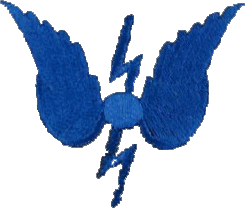|
|
|
|
|
DATE OF DESIGN |
|
1. TX 3F L/F - 1919.
2. TX 3G Low Power - 1924.
3. TX 3F H/F - 1928.
4. TX 6G - 1930.
5. Emergency Set - 1914.
6. TX 13 - 1918. |
|
FREQUENCY RANGE |
|
1. TX 3F L/F - 60 TO 500 kc/s.
2. TX 3G Low Power - 60 - 500 kc/s.
3. TX 3F H.F (later on it was fitted with a 5F) - 3500 TO 20000 kc/s.
4. TX 6G - 100 to 670 kc/s.
5. Emergency Set - 60 to 500 kc/s.
6. TX 13 - 375 to 1364 kc/s. |
|
POWER SUPPLIES |
|
1. TX 3F L/F - 8kW Alternator. Filament supply - 1.25kW Alternator.
2. TX 3G Low Power - 1.5 kW Alternator. Filament supply - 1.25kW Alternator.
3. TX 3F H.F (later on it was fitted with a 5F) - 8kW Alternator. Filament supply - 1.25kW Alternator.
4. TX 6G - 8kW Alternator.
5. Emergency Set - 20V Battery.
6. TX 13 - 1kW Rotary Converter. (See photo number 1) |
|
RANGE IN MILES |
|
1. TX 3F L/F - 700.
2. TX 3G - 100.
3. TX 3F - WORLDWIDE AT TIMES.
4. TX 6G - 150.
5. Emergency Set - 5.
6. TX 13 - 50. |
|
TYPE OF SET (VALVES USED) |
|
1. TX 3 L/F - 5.
2. TX 3G - 2.
3. TX 3F - 5.
4. TX 6G - ?
5. Emergency Set - ?
6. TX 13 - ? |
|
WAVEFORM |
|
1. TX 3F L/F - CW and ICW.
2. TX 3G - Low Power - CW and ICW.
3. TX 3F - ICW.
4. TX 6G - SPARK.
5. Emergency Set - SPARK.
6. TX 13 - SPARK. |
|
METHOD OF PRODUCING OSCILLATIONS |
|
SELF |
|
WHERE USED/FITTED |
|
Type 35S. It is the main transmitter in cruisers. The Type 13 uses the Type 35S Aerial circuits but is otherwise separate from the rest of the set. When a transmitter Type 6G is fitted, the Type 13 usually left out of the installation.
Also in this series was the Type 35M and also fitted in some cruisers. It was a medium power set, M/F, H/F and a low power set covering the frequency range of 60-500 kc/s M/F, 4000-20000 kc/s H/F, 100-1700 kc/s Low Power and all Valve sets. The two main sets were capable of CW and ICW, with the Low Power set on ICW only. All were Self Oscillators (non-M.O.) The power output/range for the M/F was rated as 450W/500 Miles; for H/F 150W/potentially world wide and 20W/40 Miles for the Low Power set, the latter being powered from a 22V Battery or ships mains power. |
|
ASSOCIATED WAVEMETER |
|
1. TX 3F L/F - 1492B or G9.
2. TX 3G - 1492B or G9.
3. TX 3F - G7 and G8.
4. TX 6G - 1492B or G9
5. Emergency Set -
6. TX 13 - 1492B or G9 |
|
FURTHER READING |
|
|
|
IMAGES, PHOTOS, DOCUMENTS, SCHEMATICS ETC.(Click images to enlarge) |
|
|
|
NOTES. |
|
The type 35S was the first of what can only be called a complicated set! It comprised of six parts, the sixth part being the Type 13 Spark Transmitter already mentioned which dated from 1918. The other five parts (1-5) were designed respectively 1919, 1924. 1928, 1930, 1914, so one could say that 1930 saw its final coming-together.
The 5F transmitter was a 3-stage master controlled H/F set fitted as an attachment to the Types 35S/M, 36S, 36M, 48, 48C as a addition and modification to the H/F side of the transmitters.
It frequency range was 14-23 Mc/s in a single band and could emit CW or ICW. The set was fitted with a cathode ray tube tuning indicator for the intermediate stage, the "shadow" on the screen of the indicator being narrowest when the stage is in tune with the master oscillator.
Photo 1 - Power supplies.
Photo 2 - Schematic for Type 13 SPARK transmitter fitted as an integral part to the Type 35S. Note the complicated aerial switch with its 'wandering' connection lead. It accommodated switching from the output of the SPARK transmitter, or the VALVE transmitter, and if the latter whether to L/F or to H/F, and when to H/F, to either the H/F transmitter or receiver.
Photo 3 - Schematic H/F Transmitter.
Photo 4 - Schematic L/F Transmitter.
Photo 5 - 35S Emergency Transmitter.
Photo 6 - 35S Transmitter Panel (part of).
Photo 7 - 35S Magnetic Key and Relay Switch.
Photo 8 - 35S Power.
Photo 9 - 35S Transmitter Panels.
Photo 10 - 35S Wavechange Linkboards. (The original page was in poor condition - the following is a transcript of what is thought to be written
To enable quick wave changing an arrangement of links is provided for varying the inductance coils in the aerial circuit.
Two linkboards are fitted, mounted on separate stands, and used for coarse and fine tuning The main linkboard is used for coarse tuning and is similar to that used with Type 36S(??) and shown here. It consists of three rows of link connections (275)(277)(276) for adjusting the upper
and lower tappings and the anode tapping leads to the main aerial coild (214). The fine tuning linkboard has two rows of link connections (278)(279) and is used for making adjustments on the ?? mic aerial coil.
To each case the connecting link can be used in one of six positions marked "A" to "I". Connections to the linkboards are made for the six frequencies more generally used. After the set has been tuned the connections to the linkboards are arranged so that the links on both
linkboards are in "A" position for one frequency, in "B" position for another frequency, and so on, thus enabling the adjustments on aerial coils to be changed quickly to any of six pre-determined frequencies.
Photo 11 - Transmitter 5F front view.
Photo 12 - Transmitter 5F rear view from right.
Photo 13 - Transmitter 5F rear view from left.
Photo 14 - Transmitter 5F with supply unit.
Photo 15 - Typical layout in Heavy Ship.
Photo 16 - Typical layout in Light Cruiser.
Photo 17 - 18" Aerial Trunk.
Photo 18 - Securing Spreading Ring to Aerial wire.
Photo 19 - Feeder Connection IF at end of Aerial.
Photo 20 - Panels. |


